FATAL SEA SNAKE bites are extremely rare in Australia. But circumstances were tragically against 23-year-old prawn trawler deckhand Harry Evans, from Dorset in England, when he was bitten just over two years ago while plying his trade in remote waters in the Gulf of Carpentaria.
An inquest in January last year documented the tragedy. It noted that the ship was north of Vanderlin Island, more than five hours from onshore medical assistance, when shortly after 8am on 4 October 2018, the nets were lowered back into the vessel and the captain noticed Harry shaking his hand in pain. Looking in the nets, the skipper found what he guessed to be an elegant sea snake, about 50cm long. He grasped it by the tail, tossed it over the side and made a call to the Royal Flying Doctor Service, while Harry’s arm was wrapped in a compression bandage.
Initially, the deckhand said he felt fine. But by 10am his condition had begun to deteriorate. The ship managed to rendezvous with medical assistance by 2.30pm, but shortly afterwards Harry was declared dead. It was a heart-breaking tragedy that was well documented by the Australian media. Associate Professor Kate Sanders, a sea snake expert at the University of Adelaide, acknowledges that despite the venom of some of the world’s sea snakes being extremely potent, it’s “incredibly uncommon” for bites to be fatal. The first fatality recorded in Australia was in 1935 and Harry Evans’ death is thought to have been the only one since.
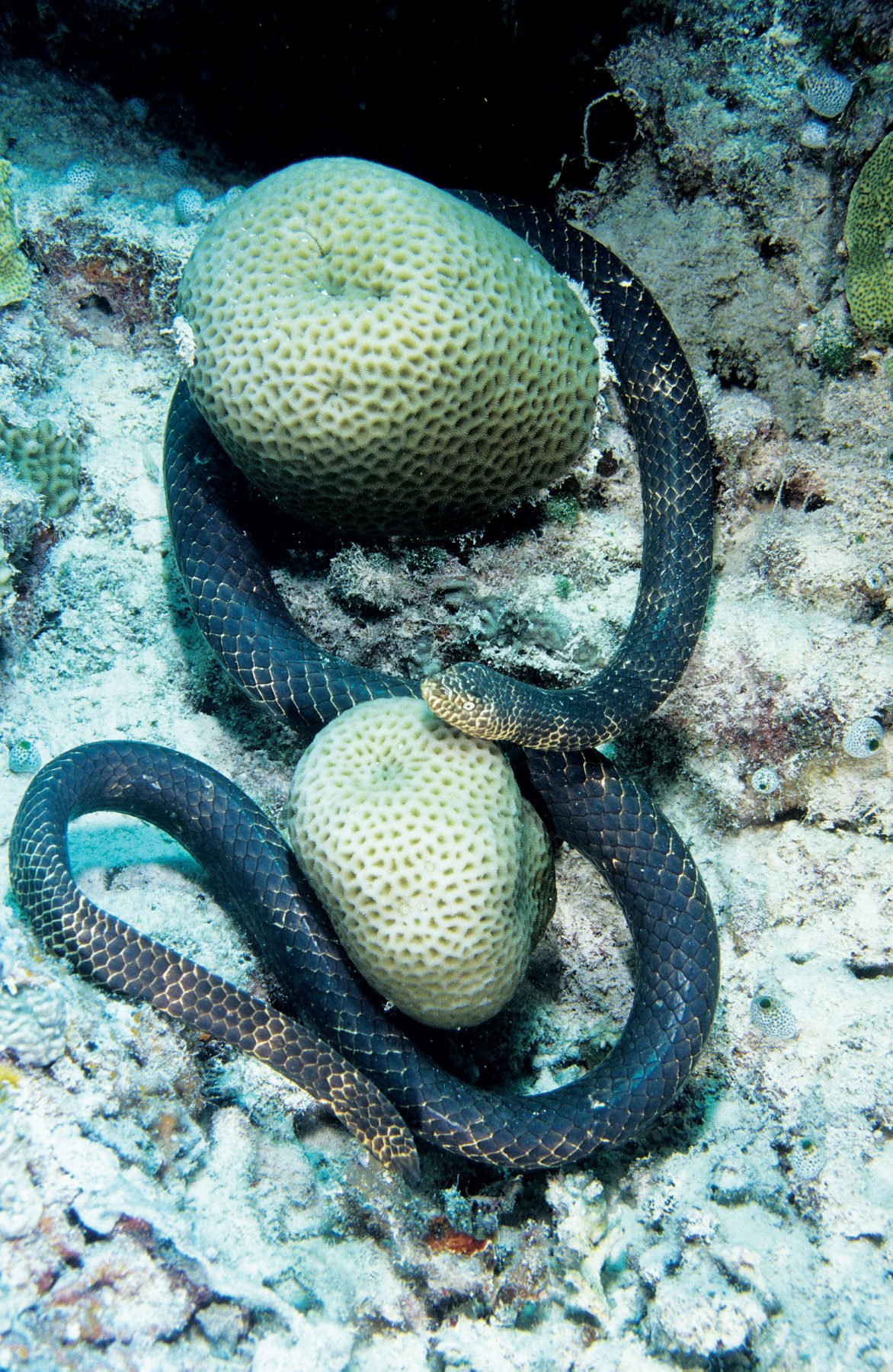
A placid snake
Swimmers, snorkellers and divers rarely experience anything more than a sea snake curiously investigating them. But trawl fishers are at greater risk. They encounter sea snakes almost daily in their nets, and the reptiles, Kate says, “are very stressed by the time someone has to handle them to take them out of the catch”.
Despite the dangers, the risks from sea snakes are not always taken seriously by fishers. “People assume they are not capable of delivering a dangerous bite,” Kate explains. While it’s true they only inject venom about half the time, the widespread belief that they only have short fangs incapable of delivering much venom is not so true. Some sea snakes have fangs as long as that of a tiger snake and can open their jaws to 180 degrees.
Sea snake biologist Blanche D’Anastasi, at the Australian Institute of Marine Science and James Cook University, in Townsville, says she knows of “a number of fishers that have been bitten”. However, rather than go through embarrassment or risk losing their job, they often don’t tell anyone. “It’s a hidden risk that requires a cultural shift,” Blanche says.
To this end both Blanche and Kate offer training to trawler crews to teach them how to handle snakes safely and what to do in the case of an envenomation. Although sea snakes are often feared, in reality they are largely docile and pose very little threat to people. They are even regarded as a tourist attraction in some places such as Shark Bay and Ningaloo Reef in Western Australia, and the Keppel Islands on the Great Barrier Reef (GBR).
“Although some species will bite when on land, they are generally quite placid in their native marine habitat,” says Professor Harvey Lillywhite, former director of the Seahorse Key Marine Laboratory at the University of Florida in the USA. Others describe sea snakes as gentle, curious and even social. “The olive sea snake in particular has this weird behaviour where they seem curious and come and check out your fins [by flickering their tongue] and even come up to your mask,” Kate says. “Some people say they’ve been chased, but it’s not remotely aggressive.”
Blanche recounts a field season in WA’s Shark Bay where one snake became increasingly comfortable with her as the days went by. It followed her from jetty to jetty until, eventually, it swam onto her back as she snorkelled. “I think it was using me as a basking platform,” she says. Also at Shark Bay she observed five pregnant females show up every day at dusk and swirl around each other. “I always wondered what they were doing,” she says. “It was the moment I realised that these are socially complex animals.”
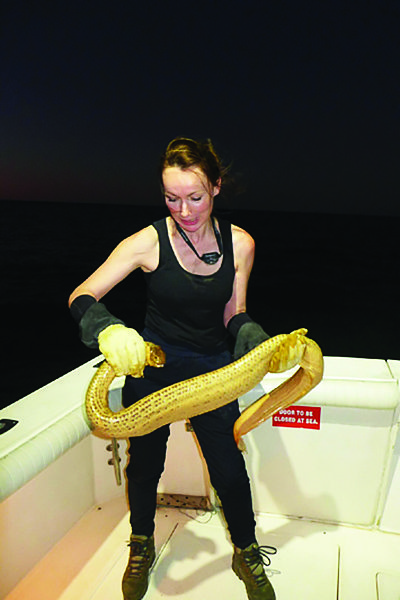
The sea snakes of Australia
Until recently sea snakes were relatively poorly known, but a recent explosion of research interest in them, much of it here in Australia, has led to a raft of new discoveries.
Sea snakes are the most diverse marine reptiles, far outnumbering sea turtles and crocodilians in species number. There are two evolutionary lineages of marine snakes, which come from land-living ancestors that invaded the ocean on different occasions.
True sea snakes are part of the venomous elapid snake group that is common in Australia. They evolved, perhaps 20–10 million years ago, from an ancestor similar to modern-day tiger snakes. Numbering about 70 species, true sea snakes are fully adapted for life in the ocean and are mostly found across the Indo-Pacific from Southeast Asia through New Guinea to Australia.
The semi-aquatic sea kraits are an earlier evolutionary offshoot of venomous snakes. They still come on to land to bask, drink water and lay their eggs. There are only eight species, none of which are permanently resident here.
The true sea snakes originated in Australia, which is the centre of their diversity, and there are about 36 named species here. North-western Australia is a particular hotspot with about 24 species: the remote Exmouth Gulf, where Blanche works, 1100km north of Perth, has about 15 species alone. But sea snakes are found all the way throughout the tropical north, from Shark Bay around to New South Wales.
Because sea snakes must surface to breathe air, they typically inhabit shallow habitats, from coral reefs and seagrass meadows to coastal rivers. Some specialise in snatching eels from their burrows and have shrunken heads and narrow forebodies suited to the task. Others feed on fish eggs and have lost the need for large fangs and potent venom.
For true sea snakes, the evolutionary leap to fully marine creatures – which not even egg-laying sea turtles can claim to be – was no small feat. Their tails became flattened and paddle-like; they acquired glands under their tongues that excrete excess salt and valves to seal their nostrils; and they capitalised on the ability to bear live young by expelling them directly into the water.
“They are a great example of the process of evolution and how a new body plan and anatomical features can evolve in response to a new environment,” says Dr Alessandro Palci, an evolutionary biologist at Adelaide’s Flinders University.
All reptiles have tiny bumps on their heads called scale sensilla with which they sense objects by touch and pressure. Research from Kate’s group, published in 2016, showed sea snakes have taken this ability to the max, employing sensilla covering a much larger area to detect movement in the water.
Dr Jenna Crowe-Riddell, one of Kate’s students, was lead author of a study in the journal Open Biology, which reported that sea snake sensilla are highly dome-shaped, allowing them to sense vibrations from all directions. “Sea snakes use these organs to sense objects at a distance by ‘feeling’ movements,” Jenna told reporters. “In water, a new way of sensing the environment becomes possible. Every movement of a fin or flipper generates vibrations.”
Another startling discovery was that some species can detect light with their tails. “It was observed by night divers on the GBR that some olive sea snakes will withdraw their tail paddle in response to torch light,” Kate says, explaining that this allows them to ensure their vulnerable tail tips, which are located far from sensory organs on their heads, are protected.Working in waters off Broome, she and Jenna were startled by how “decisively” olive sea snakes would repeatedly withdraw their tails when light was shone on them, Kate says. Research led by Jenna and published in Molecular Ecology in 2019 showed that these snakes express in their tails a series of light-receptor genes that are usually expressed in the retina of the eye.
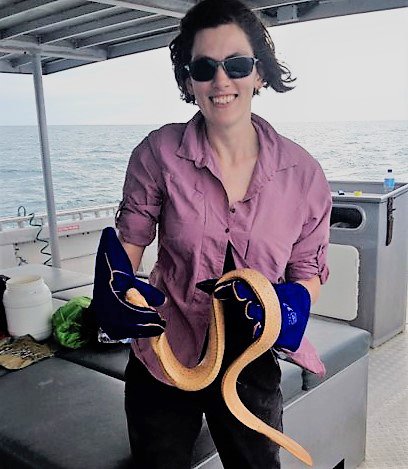
Kate says something else that shocked her was footage of one species at incredible depths in the Kimberley’s Browse Basin. “A subcontractor of a ROV [remotely operated vehicle] for a big oil and gas company contacted us with footage of a sea snake foraging at 250m deep,” she says. “That really sort of blew us away.”
There’s still much to learn about how snakes are achieving such deep dives, but part of the answer may lie in findings published by Alessandro in 2019. His micro-CT (3D imaging that uses X-rays to see inside objects) scans of blue-banded sea snake skulls and heads revealed an extensive network of capillaries in the skin that absorb and carry oxygen to the brain. “It’s an additional supply of oxygen for the brain, because all these blood vessels in the front of the snout converge in these large blood vessels that pass through the hole in the braincase,” Alessandro says. “This sea snake uses its head as a gill to breathe under water.”
It’s a “mind-blowing” ability, Blanche agrees. “Just wondrous.” Certainly, some sea snakes do seem to have a remarkable ability to remain under water for long periods; they routinely remain submerged for two hours or more when diving to forage, or while sleeping on the sea floor.
While true sea snakes have almost entirely severed their connection with land, they still need to drink fresh water: work by Harvey in Florida has attempted to probe the conundrum of how they do this. The old dogma was that sea snakes subsisted solely on sea water. However, while they excrete salt, it’s not enough that they can survive on salt water alone. “Contrary to previous thought, they…require fresh water,” Harvey says. “Sea snakes [also] cannot make a water profit solely from eating their prey.”
Published in the journal PLOS ONE in 2019, his work on yellow-bellied sea snakes, which live in the open ocean, showed they keep hydrated by drinking so-called lenses of fresh water that form on the sea surface after heavy rain. “The evidence is largely indirect, but there’s lots of it,” he says. “It requires amazing luck to observe this in the open sea.”
One thing he and his team have observed in the laboratory is that when some sea snakes are dehydrated and placed in fresh water, they swim up and drink at the surface. “I believe this reflects evolutionary adaptation to utilise relatively fresh water that tends to remain at the surface when it rains,” Harvey explains.
Studying sea snakes is difficult because they’re hard to find. That, along with the risk of being bitten, may be why, until relatively recently, few researchers have worked on them.
To catch sea snakes, many researchers simply snorkel and dive. But Blanche’s favourite method is more complicated. She hangs off the back of a boat on a rope, scanning side to side for snakes and when she spots one, dives down and catches it in a bag. Back on the boat she puts it in a plastic box with measuring guides on the bottom. A clear shield protects her while she takes a tail tissue sample for DNA analysis before applying antibacterial cream and releasing the snake back into the ocean.
Kate’s team also catches snakes and takes tissue samples. She loves the serenity of watching them from a boat at night; some species sleep near the surface and shine in a torch beam. “Academic life is so frantic that I particularly enjoy searching for snakes at night on flat tropical seas,” Kate says. “It’s quite meditative.”
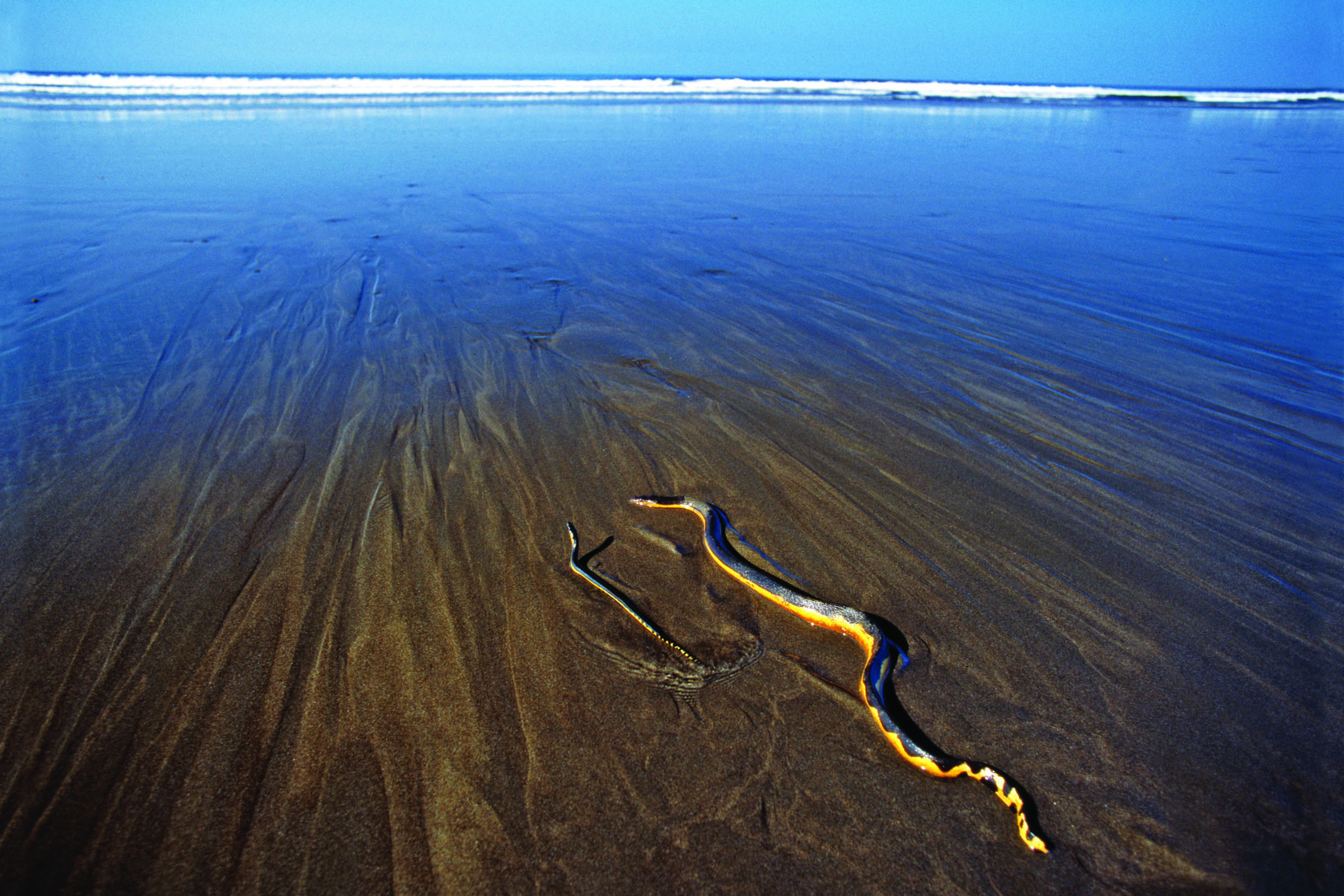
Sea snake conservation
Many sea snake populations are seriously threatened. In Australia, intentional fishing and persecution of these reptiles is rare. Elsewhere, the situation is often different. A study a decade ago, for example, revealed that Vietnamese squid-fishing vessels in the Gulf of Thailand were then taking more than 200,000 sea snakes a year. Most were bound for China, where consuming sea snakes is deemed to offer health benefits.
Work by one of Kate’s students in Thailand has recently revealed that catch rates have since dropped dramatically, suggesting some populations there may have collapsed. “Reptiles generally are among the most intensively traded of all species,” she notes.
There is strong evidence of declines elsewhere too. As recently as the 1960s, the Indian Ocean’s remote Ashmore Reef, 610km north of Broome, had more sea snakes than anywhere else in the world. Seventeen species were recorded across this 583sq.km region – mind-boggling diversity, when you compare it to the 16 species found across the entire 344,000sq.km of the GBR. Why the remote region was such an incredible sea snake diversity hotspot in the first place was as much a mystery as why nearly all of its sea snakes had vanished by 2012.
“It not only had the highest number of species in a single location, it had the highest densities of sea snakes known,” Blanche says.
Most species there now appear locally extinct, linked possibly to habitat degradation, fishing or disease, nobody really knows. It makes researchers fear that similar sudden declines could occur elsewhere, even where snakes are currently thought to be secure. Work by both Kate and Blanche led to the discovery of some of Ashmore Reef’s missing species in WA.
Blanche’s fieldwork in the seagrass meadows of Shark Bay, for example, led to the surprise rediscovery of the leaf-scaled sea snake. “The first snake I interacted with in my whole life was one of these extinct species,” Blanche says, “and [after its rediscovery] we extended its geographic range southward by about 1800km.”
Even here at Shark Bay, a World Heritage area, sea snakes are not safe from the impacts of climate change. Before 2010, Shark Bay had the world’s third-largest area of seagrass meadow, but an unprecedented heatwave that year, which saw water temperatures rise for 10 weeks to 2°C to 3°C above average, led to a 40 per cent decline in dense seagrass and a 76 per cent decline in sea snakes.
Blanche’s research has shown that, to compound the problem, species such as the olive and Shark Bay sea snakes show incredible fidelity to specific sites, never travelling far from home. “When you lose them from a location, you lose them potentially for good,” Blanche explains. “There are very
few immigrants between populations, and it would take hundreds to thousands of years for populations to recover lost genetic diversity.
“That’s really concerning, because we are seeing sea snakes going through precipitous declines in places where they were previously abundant.”
Snakes can also be highly adapted to local conditions at a site, so if we are pinning our hopes for conservation on translocating snakes to top up populations elsewhere, there is no guarantee this would work. “It’s fraught with danger and the truth is we have to protect their habitat and limit localised impacts as the first course of action,” Blanche says.
Although sea snakes are less threatened by fishing in Australia than they are throughout Southeast Asia, they are caught here as bycatch by trawlers in high numbers, and may be fatally injured in the process. Snakes here are also at risk from port dredging, coastal developments, pollution, collisions with vessels and seismic testing.
Despite the threats that stem from the impact of climate change and habitat loss, it is very difficult to assess the conservation status of many species because not enough is known about them to even determine if populations are declining.
“There are just these massive gaps in our knowledge,” Kate says. “For about 43 per cent of species we have no idea what’s going on, but many populations are likely to be threatened with extinction.” Just a few species have their conservation status listed as endangered, critically endangered or vulnerable on the IUCN Red List of threatened species, while more than a third of all sea snakes are marked as “data deficient”. So much has yet to be learnt about sea snakes that, based on DNA work, say the experts, there are more than 10 new species waiting to be described, many of which occur in Australia.
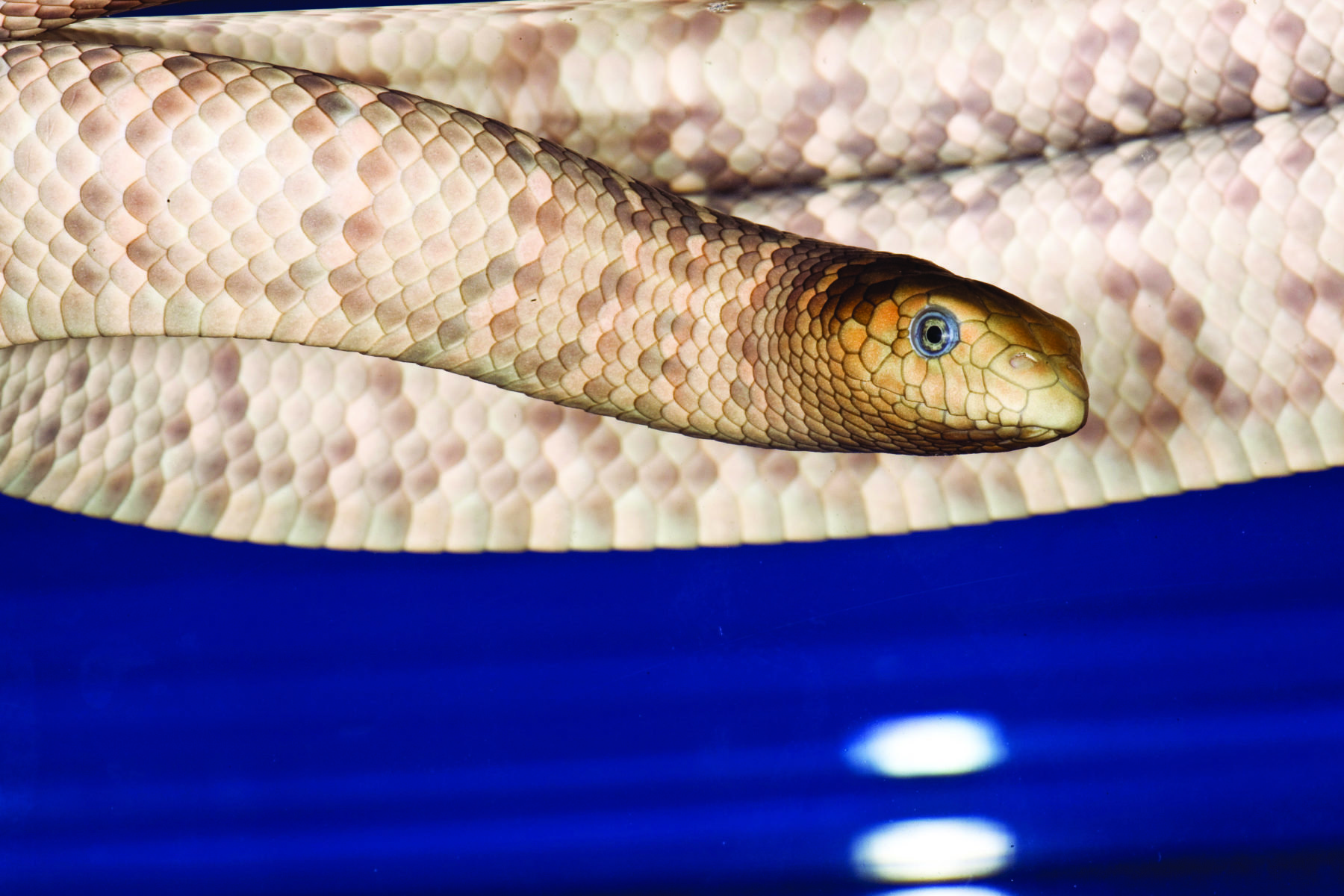
Madly in love
Despite the risk to trawl fishers, such as 23-year-old Harry Evans, it’s not possible for commercial vessels to carry antivenom. The drug expires after 6–12 months and must be replaced, and it costs up to $3000 a vial, of which three may be needed against a single envenomation. Furthermore, potential sea snake–bite victims must be tested first for evidence of tissue breakdown, because if you haven’t been envenomated, the antivenom itself can kill you.
Blanche says if some good can come from the 2018 tragedy it’s to remind everyone, particularly trawl fishers who interact with sea snakes daily, about snake bite first aid. “If you get bitten, just stop, get yourself wrapped up and give yourself a minute to think, which is absolutely life-saving,” she says. “Get a proper snake-bite bandage with stretchy guides that tell you how tight to make it and get that on.” Most trawl fishers are many hours from help out at sea, but getting the bandage on and “keeping that person calm and stopping them from moving is the key thing you can do to extend their window for survival”, she adds.
The obvious perils of working on such venomous snakes may have put off some researchers. But since her first encounters, Blanche says, she fell “madly in love” with sea snakes. “They are these incredible social reptiles with this scintillating array of adaptations to marine life – bumps on their heads that detect water vibration, head gills that pump oxygen into their brains and light sensors on their tails,” she says. And Kate agrees, adding that “sea snakes are one of Australia’s contributions to the world”.
from Hacker News https://ift.tt/3x8Xb3b
No comments:
Post a Comment
Note: Only a member of this blog may post a comment.